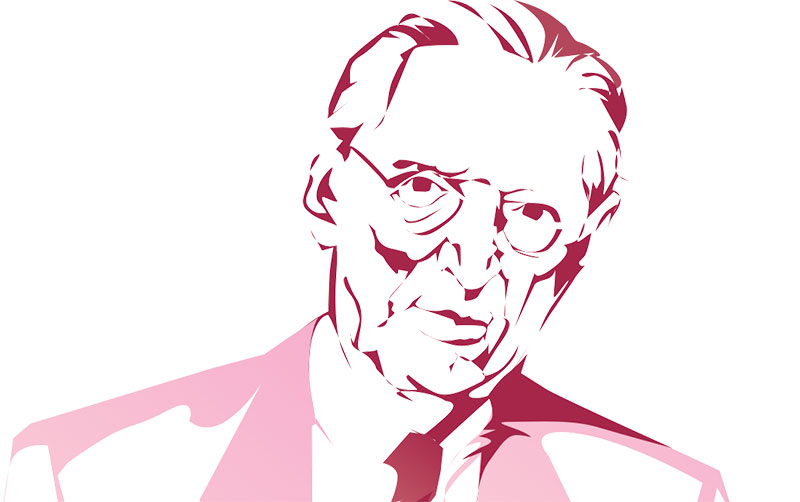Even at the age of 103, Howard Jones Jr., M.D., still goes into his office for several hours each day to work on articles and consult on fertility studies.
In a 2011 article about longevity, Dr. Jones credits his late wife and their research for helping him stay vigorous. “During our decade in reproductive medicine, our focus evolved along with the changing nature of the field. We forged into new territory and constantly challenged ourselves…Retirement at age 65 is not, repeat not, consistent with longevity. The simple message for longevity: do not retire from intellectual pursuits,” he says.
A Partnership of Minds and Hearts
And their intellectual pursuits are internationally famous. Although forced to “retire” at age 65 from Johns Hopkins Hospital, he began another career as one of the founders of the Jones Institute for Reproductive Medicine, along with his wife Georgeanna Seegar Jones, M.D., an endocrinologist.
Howard and his wife began dating in medical school, but knew each other from Baltimore where their fathers, both doctors, worked together. During their courtship, they often went to the pathology laboratory, which was open in the evenings. They peered together through microscopes, and their love grew.
They married, and for the next five decades, they shared an office. Their work and home life were intertwined as tightly as a double helix.
During World War II, Dr. Jones served in the U.S. Army as a battlefield surgeon in Germany and Belgium. He and his wife (he called her Ginny) kept a brisk correspondence, talking about their family and their work in letters back and forth across the ocean. Many of these letters are captured in a book called “War and Love: A Surgeons Memoir of Battlefield Medicine with Letters to and from Home.”
Their relationship influenced their work, with Georgeanna’s work in endocrinology and gynecology drawing Howard from surgery into reproductive medicine. Both of them were fascinated by the inefficiency of human fertility. “I started my career in oncology, but was so taken up with the volume of infertility. Only 20 percent of fertilized eggs make a baby,” he says.
Today, Jones says that our understanding of fertility is much improved, but that people often don’t plan properly around one of the most controllable factors: the age of the mother at conception. “I see lots of situations where at 39, the woman changes her mind and decides she wants children. But fertility declines with age, and the idea of waiting five more years may not be realistic. Consider it early on,” he recommends.
After working for Johns Hopkins Medical School for more than 30 years, they decided to join the young Eastern Virginia Medical School in Norfolk, Va. There, they worked with Robert Edwards to successfully perform the first in vitro fertilization (IVF) in the United States in 1981, after the first-ever procedure in England. It was controversial then, although very common now, with an estimated five million babies born through IVF worldwide.
“IVF can really help women with physiological issues such as stress affecting their menstrual cycle. It may be subtle but that can happen. One of the remedies for being stressed out about not getting pregnant is: getting pregnant!” he says. These pioneers in the treatment of infertility blended their love of medicine with their desire to help people grow their own families. In their own family, two of their three children are also physicians, with their oldest son becoming an obstetrician/gynecologist and their daughter becoming a professor of pediatrics. It continues into the next generation, with two grandsons practicing as physicians as well.
Another fun fact about this couple? Georgeanna’s father delivered baby Howard, in the Jones family home, on Dec. 30, 1910. This long partnership returns to the same theme again and again: a love of learning, and sharing of love.
My darling,
It hardly seems possible that being away from someone can really hurt, but it does. Every once in a while the funny little pain in my left chest just gets too unbearable, and I really believe I miss you most when I am trying to do something interesting.
I’ve been at the laboratory all afternoon, trying to analyze our habitual abortion cases, and they certainly are interesting—if you were only here to discuss it.
All my love,
Ginny
Dearest Ginny,
Valentine’s Day. I hope the little collar I sent got there. It’s a poor substitute for an adequate expression of love and I should much rather put my arm around your neck than any collar, but c’est la guerre.
I have noticed a few articles recording the use of intravenous flourescein in studying the circulation in various things like pedicle grafts, pinch grafts, burns, etc. Would this have any application in studying the endometrial circulation in the menstrual cycle?
All my love,
H

